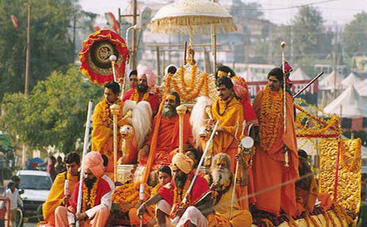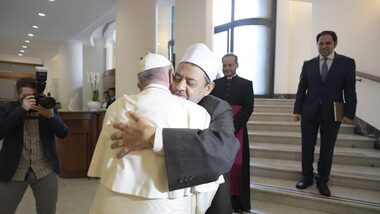
The Sangam (the point of confluence of the three rivers) is a particularly holy spot associated with one of the many myths of the Hindu faith. The story comes from the Vedic scriptures and tells of the time when angels and demons churned up the ocean, seeking the nectar of immortality. Not surprising conflict ensued and a deadly poison began to emerge from the water, which was swallowed by the god Shiva before it could destroy the world. Many gifts were then given to the world including the nectar of immortality (amrit) contained in a large jar called a Kumbh. There was the possibility of the demons taking possession of it until one of the devas, transformed into a large bird known as Jayanta, took the pitcher up to paradise and on his way he stopped in four places where a drop of nectar fell into the river. Each of these places has become a holy place of pilgrimage and a Kumbh Mela takes place in each of them on a rotational basis. But every 12 years the Kumbh Mela takes place in Allahabad, considered to the be the most sacred of the four pilgrimage locations. And every 144 years a Great Kumbh Mela takes place. At the last one in 2013, 120 million people attended and it’s estimated that as many as that will attend the present one.
The organisation for such an event is immense. A city of tents has been set up, spread over 12 square miles; hundreds of new roads have been laid and 120,000 toilets erected. 15 lost-and-found camps have also been set up. And the pilgrims will come in their millions. The first to bathe in the sacred rivers are members of religious orders and the holy men, the sadhus, who have abandoned their former life to commit themselves totally to prayer and asceticism. The sadhus are often completely naked with ash-smeared bodies and they come from all over India to join in a great procession in which some are riding on elephants, camels and horses, there are brass bands and drummers, religious leaders on several vehicles throwing marigolds to thousands of devotees and impromptu entertainment along the way. It is a jamboree and until 6 years ago was limited to men but now women ascetics are allowed to bathe on the auspicious first day. It’s only after these holy men and women have rushed into the sacred river and been cleansed that ordinary pilgrims are allowed to bathe, believing that they can somehow participate in the holiness of the saintly who have bathed in the waters before them.
The whole atmosphere at the Kumbh Mela is that of a medieval faith but for the individual pilgrim it’s a religious experience. I haven’t been to a Kumbh Mela but I have been to Allahabad. It was a long time ago, in 1986, and while the Kumbh Mela had taken place in Hardwar that year there had been a Magh Mela, a much smaller annual pilgrimage in Allahabad. My memory is that there was a sense of the emptiness about the pilgrimage area, of the night after the party, a presence more palpable in its absence than anything else, a spirit of a party that had been, the ghostly lingering of an energy now gone. And there were pilgrims there though not in their thousands.
I was with two Hindu friends, a husband and a wife who was anxious to bathe at the Sangam. We hired a boat and were rowed out to the point where the rivers merged. Unbelievable as it seems, there is a point where the rivers Ganges and Yamuna meet and you can actually see the different colours of the two rivers. The third river, the Saraswati, is underground and mythical but there is a sense of sacredness about the spot, I can recall, though, will all things religious, there is also the opposite. As we reached the sacred spot a boat came alongside ours containing an ornate shrine attended by a priest who performed a puja to the goddess Saraswati. My friends were encouraged to make a donation for a coconut that was then offered to the river. I was the observer in this act of devotion so the only one that saw another boat collect the coconuts, no doubt to sell them on to other pilgrims. I can’t remember if I was a bit shocked at this but I would now be much more tolerant and even amused at religious idiosyncrasies such as this. What I do remember, however, and it has had a lasting effect on me, was my friend bathing at that sacred spot and her emotion as she experienced the joy of believing her sins had been forgiven and that she had touched even for a moment the liberation of that nectar of immortality.
It’s this that’s at the heart of the Kumbh Mela and reveals its true meaning. As with all religions it’s important to look beyond the razzmatazz and externals to see the beauty of the truth hidden deep within them. I’m grateful I had such an experience at Allhahabad.



 RSS Feed
RSS Feed
